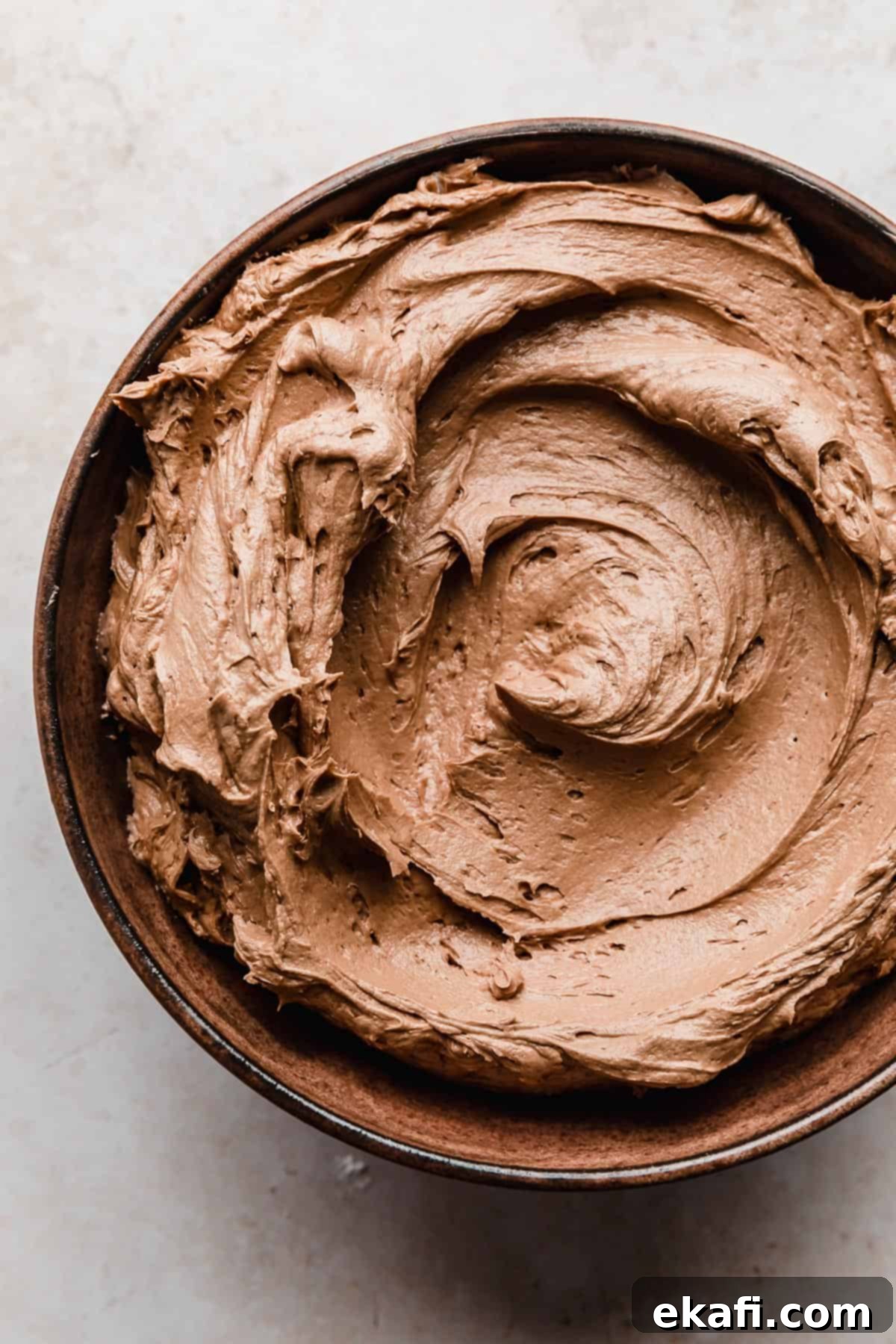Decadent & Silky Smooth Chocolate Buttercream Frosting with Melted Chocolate (The Ultimate Recipe)
Prepare to elevate your baking with this absolutely divine Chocolate Buttercream with Melted Chocolate. This frosting isn’t just sweet; it’s a celebration of deep, authentic chocolate flavor and an irresistibly smooth, light, and fluffy texture. Forget gritty cocoa powder frostings – our secret ingredient, real melted chocolate, creates a buttercream that glides effortlessly, making it the perfect companion for your favorite baked goods. Whether you’re frosting a moist chocolate cake, a classic yellow cake, or a batch of delightful cupcakes, this recipe promises a professional finish and a taste that will leave everyone asking for more.
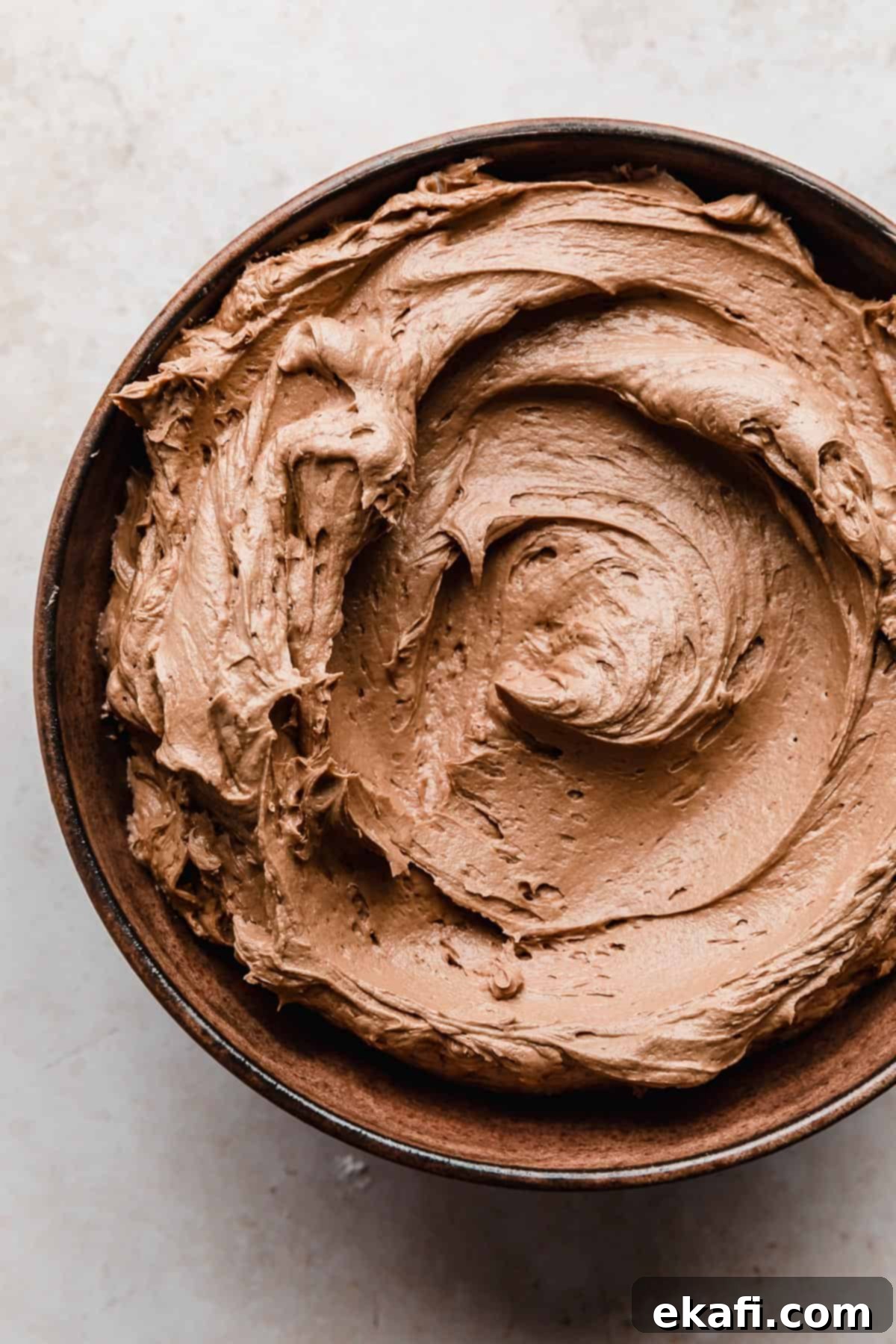
Why This Chocolate Buttercream Recipe Stands Out
Not all chocolate frostings are created equal. This particular recipe has become a favorite for its unparalleled texture and depth of flavor. Here’s what makes it truly special:
- Authentic Chocolate Flavor with Real Chocolate: Unlike many recipes that rely solely on cocoa powder, our chocolate buttercream achieves a genuinely rich and profound chocolate flavor by incorporating real melted chocolate. We recommend using a high-quality semi-sweet or bittersweet chocolate bar. This method infuses the buttercream with the pure essence of chocolate, creating a more sophisticated and less intensely sweet profile than cocoa powder alone can provide. The result is a richer, more complex chocolate experience.
- Achieve Silky Smooth Perfection: The key to an incredibly smooth buttercream lies in the melted chocolate. When chocolate melts, it creates a wonderfully smooth emulsion, which translates directly into the frosting’s texture. We specifically opt for baking chocolate over chocolate chips because baking chocolate contains fewer stabilizers, allowing it to melt more uniformly and yield an even silkier consistency. This careful choice ensures your buttercream is free of any grittiness and possesses a luxurious mouthfeel.
- Effortless American Buttercream: This recipe simplifies the art of frosting. Classified as an American buttercream, it’s renowned for being the easiest and most straightforward type of buttercream to prepare. With minimal steps and readily available ingredients, even beginner bakers can achieve professional-looking results. It’s a testament to how simple ingredients can yield truly spectacular outcomes when combined correctly.
- Incredibly Versatile for Any Dessert: Beyond its superior taste and texture, this buttercream is incredibly versatile. It holds its shape beautifully for piping intricate decorations, yet remains spreadable for smooth, even coats on cakes. It’s robust enough for a multi-tiered cake and delicate enough for simple cupcake swirls, making it your go-to chocolate frosting for virtually any dessert occasion.
Essential Ingredient Notes for Perfect Chocolate Buttercream
Crafting the perfect chocolate buttercream starts with understanding your ingredients. Each component plays a vital role in achieving that sought-after rich flavor and silky-smooth texture.
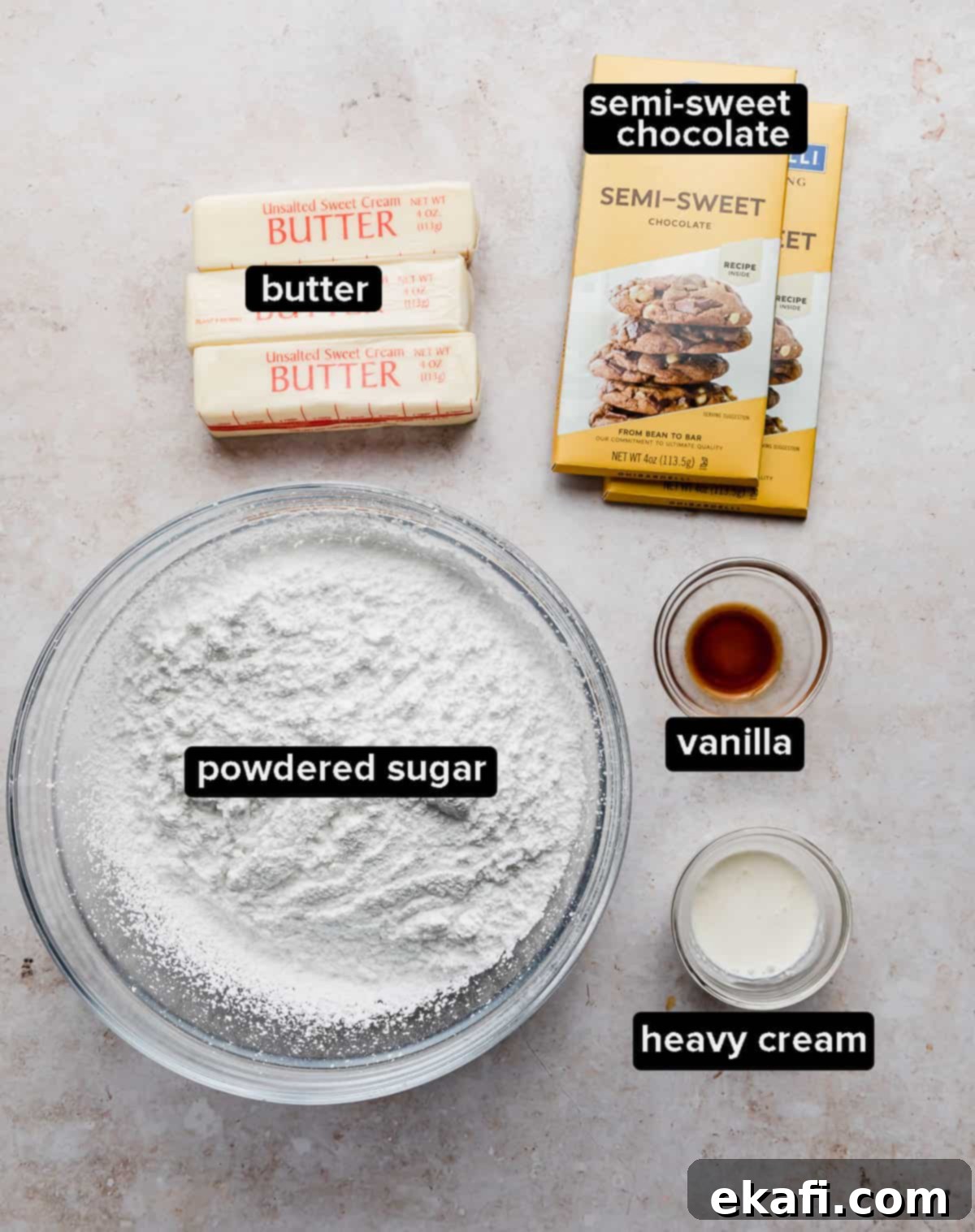
- Unsalted Butter: The cornerstone of any great buttercream. For optimal results, use slightly chilled room temperature butter. This means it shouldn’t be rock-hard from the fridge, nor should it be overly soft and greasy. It should still feel cool to the touch and offer a slight resistance when pressed. Aim to take it out of the refrigerator approximately 20-30 minutes before you start. If your butter is too soft, the buttercream will struggle to achieve the desired light and fluffy texture, potentially becoming runny and difficult to work with. Too cold, and it won’t cream properly.
- Powdered Sugar (Confectioners’ Sugar): This provides the sweetness and structure to our buttercream. For an exceptionally smooth, lump-free frosting, it’s absolutely crucial to sift your powdered sugar before adding it. Adjust the amount to your taste; if you prefer a sweeter frosting, add more, but be mindful that this may require a touch more heavy cream to maintain a smooth, spreadable consistency.
- Semi-Sweet Chocolate: This is where the magic happens! We recommend using a high-quality semi-sweet or bittersweet chocolate bar (like Ghirardelli, as mentioned). Using a chocolate bar, finely chopped, ensures a much smoother melt and a richer, more profound chocolate flavor compared to cocoa powder. The absence of stabilizers found in chocolate chips allows it to emulsify seamlessly with the butter, creating that coveted silky texture.
- Vanilla Extract: A crucial flavor enhancer. Even in a chocolate frosting, a good quality vanilla extract brightens the chocolate notes and adds a layer of complexity to the overall taste. Don’t skip it!
- Heavy Cream: This ingredient acts as a liquid stabilizer and consistency adjuster. Start with the recommended amount, but keep a little extra on hand. You can add more, a tablespoon at a time, to achieve your desired spreadable or pipeable consistency if the frosting is too thick.
Easy Step-by-Step Instructions for Perfect Chocolate Buttercream
Follow these simple steps to create a luscious, rich, and silky smooth chocolate buttercream frosting that will impress every time.
- Prepare the Chocolate: Begin by finely chopping your semi-sweet or bittersweet chocolate bar. This helps it melt more evenly and quickly. Place the chopped chocolate in a microwave-safe bowl and microwave at 50% power, stirring thoroughly every 30 seconds, until it’s completely melted and smooth. Once melted, set it aside to cool to room temperature (about 5-10 minutes) while you proceed with the other steps. It’s critical that the chocolate isn’t hot when added to the butter, as this could melt your buttercream.
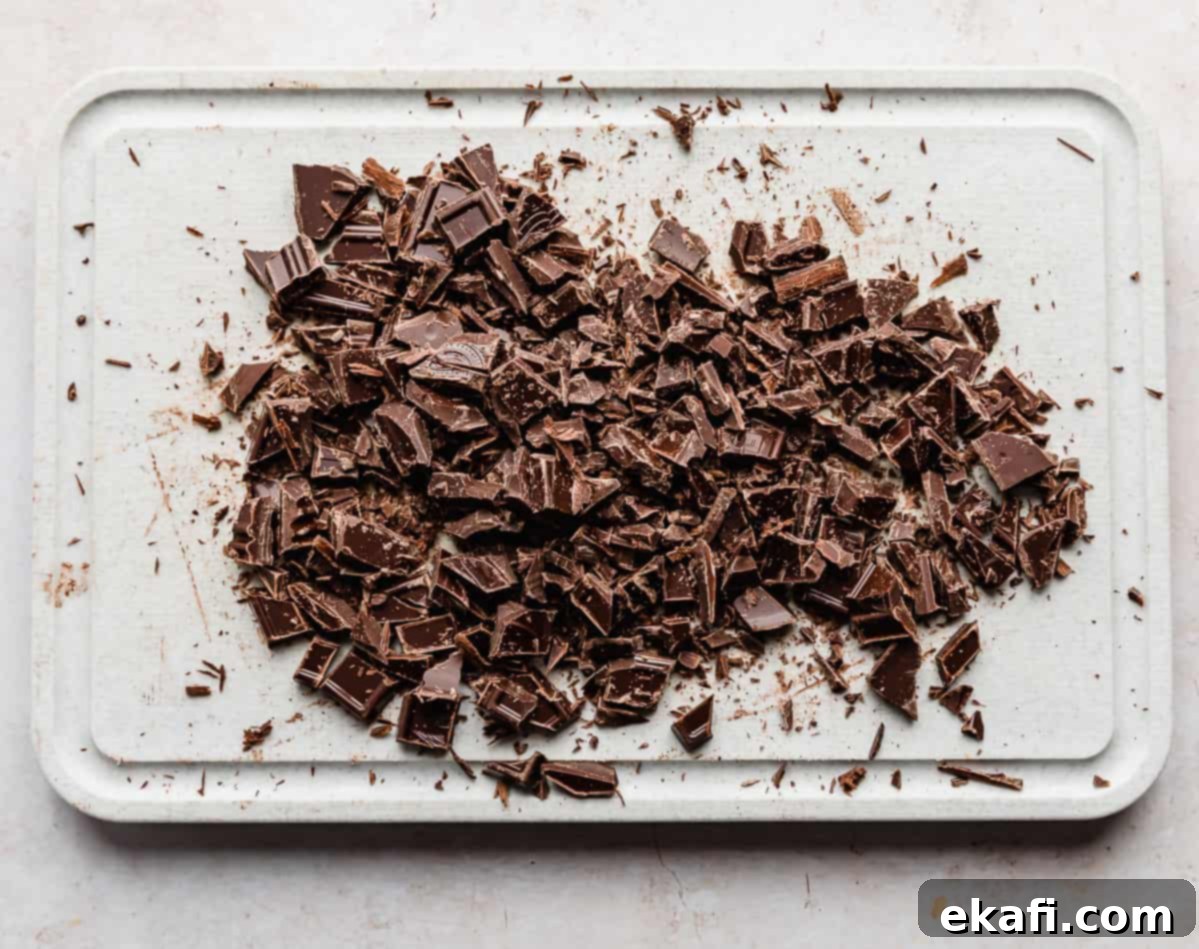
- Cream the Butter: In the bowl of a stand mixer fitted with the paddle attachment, cream the slightly chilled unsalted butter on medium-high speed. Beat for 2-3 minutes until the butter becomes noticeably lighter in color and takes on a wonderfully fluffy, airy texture. This aeration is crucial for a light buttercream.
- Incorporate Powdered Sugar and Vanilla: Once your butter is perfectly creamed, reduce the mixer speed to low and gradually add the sifted powdered sugar, a little at a time, to avoid a sugar cloud. Once fully incorporated, add the vanilla extract. Increase the speed to medium and beat for another 30 seconds to combine everything well. Don’t forget to scrape down the sides of the bowl to ensure even mixing.
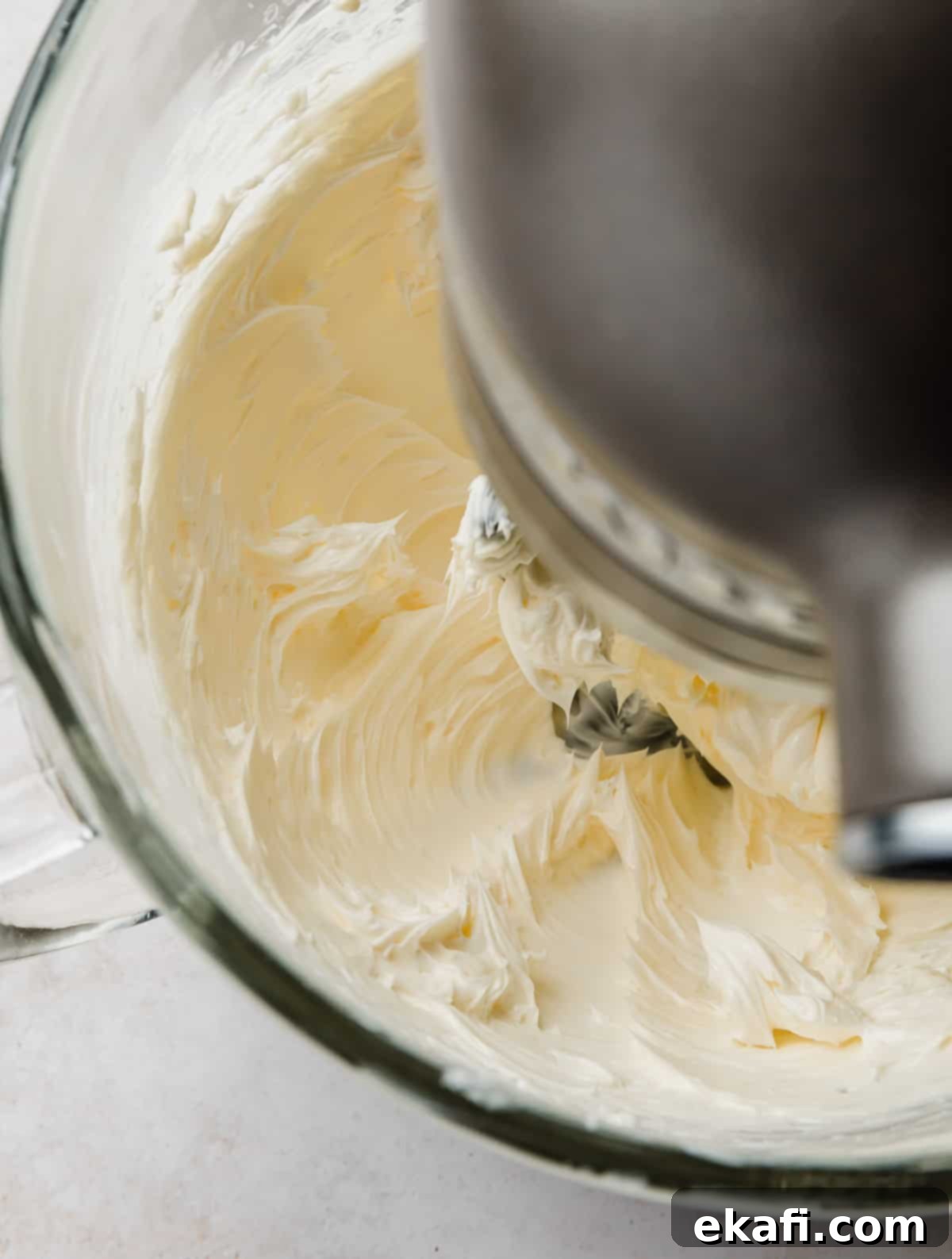
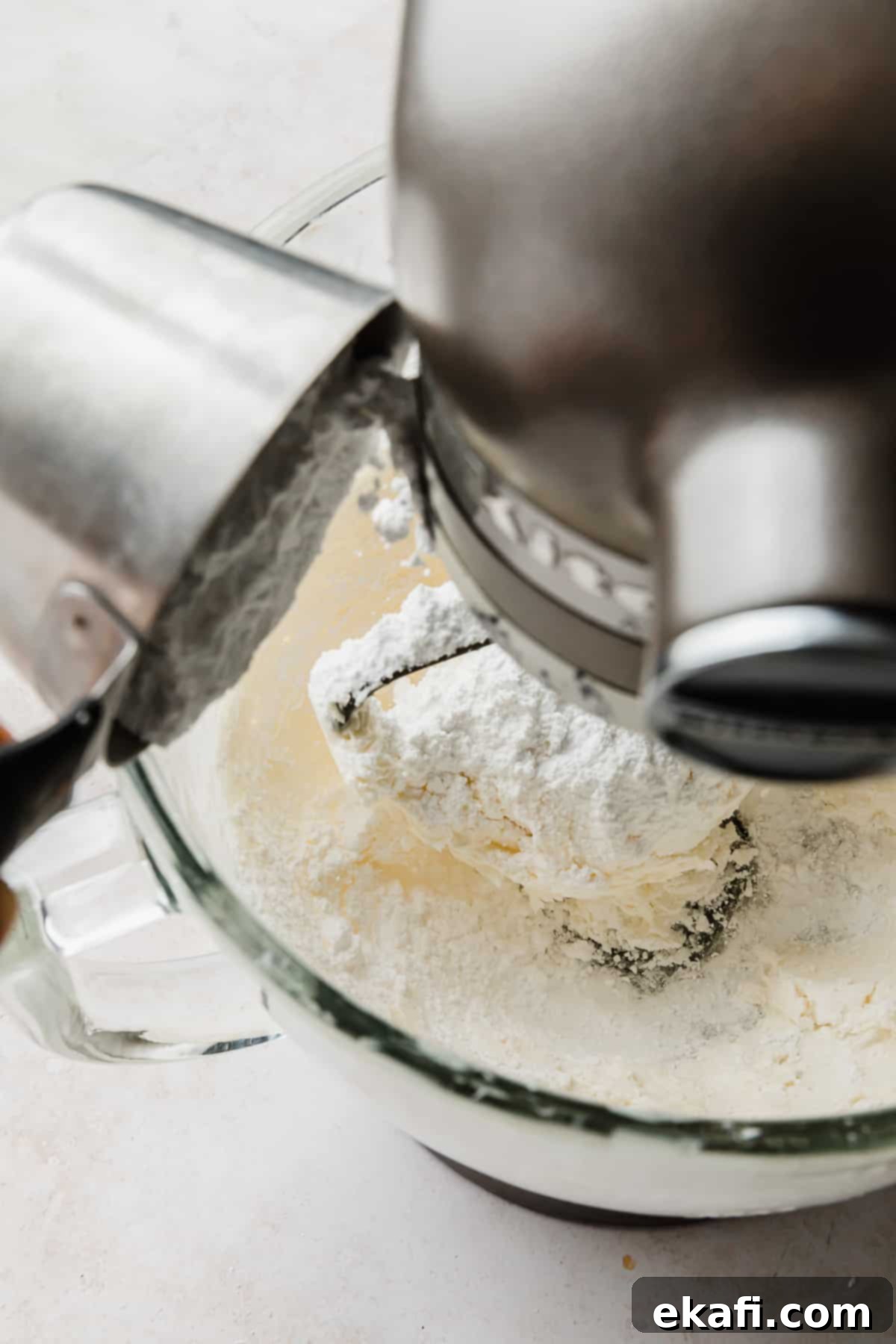
- Add the Melted Chocolate: With the mixer on low speed, slowly pour the cooled, room-temperature melted chocolate into the butter and powdered sugar mixture. Mix until just combined.
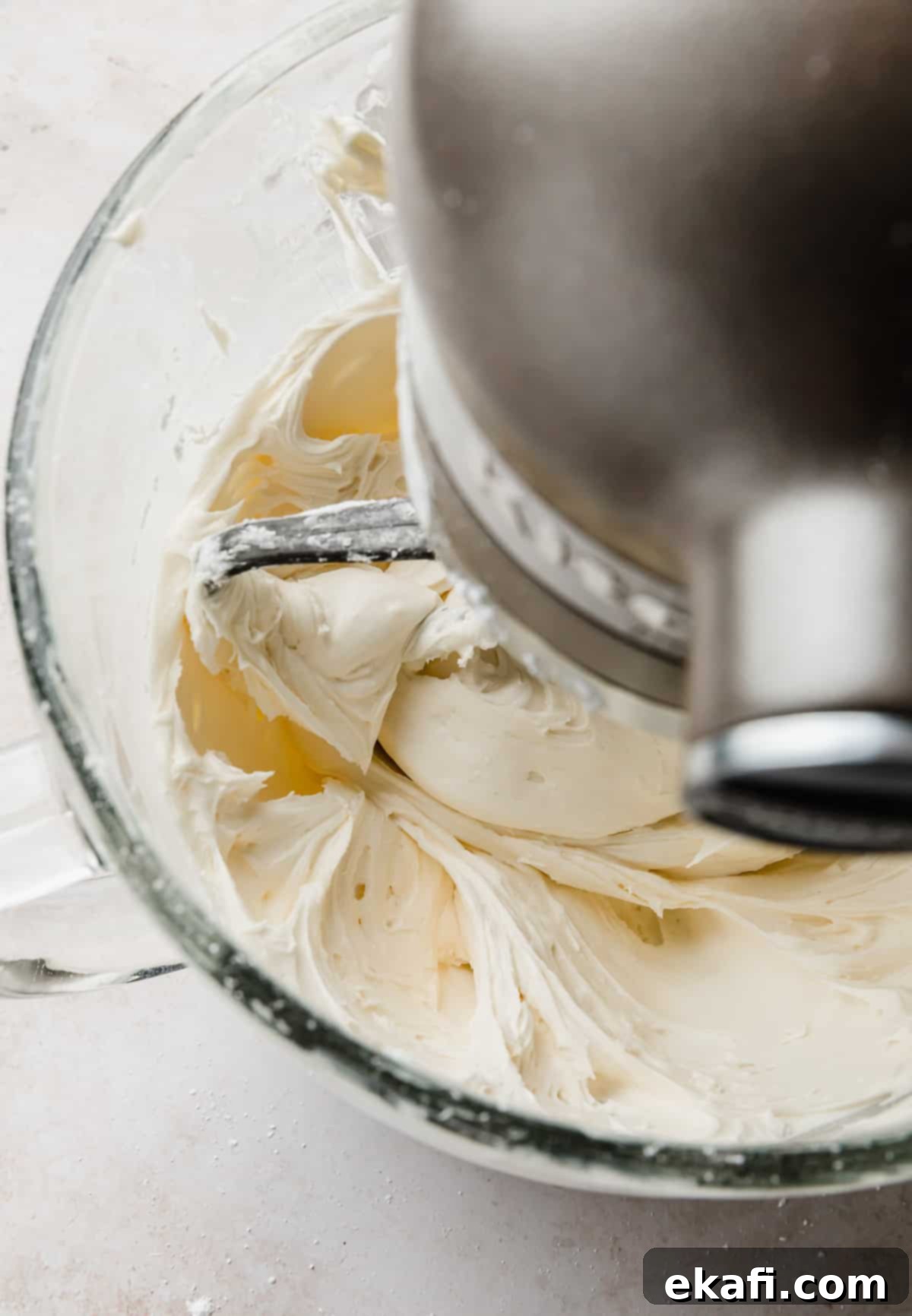
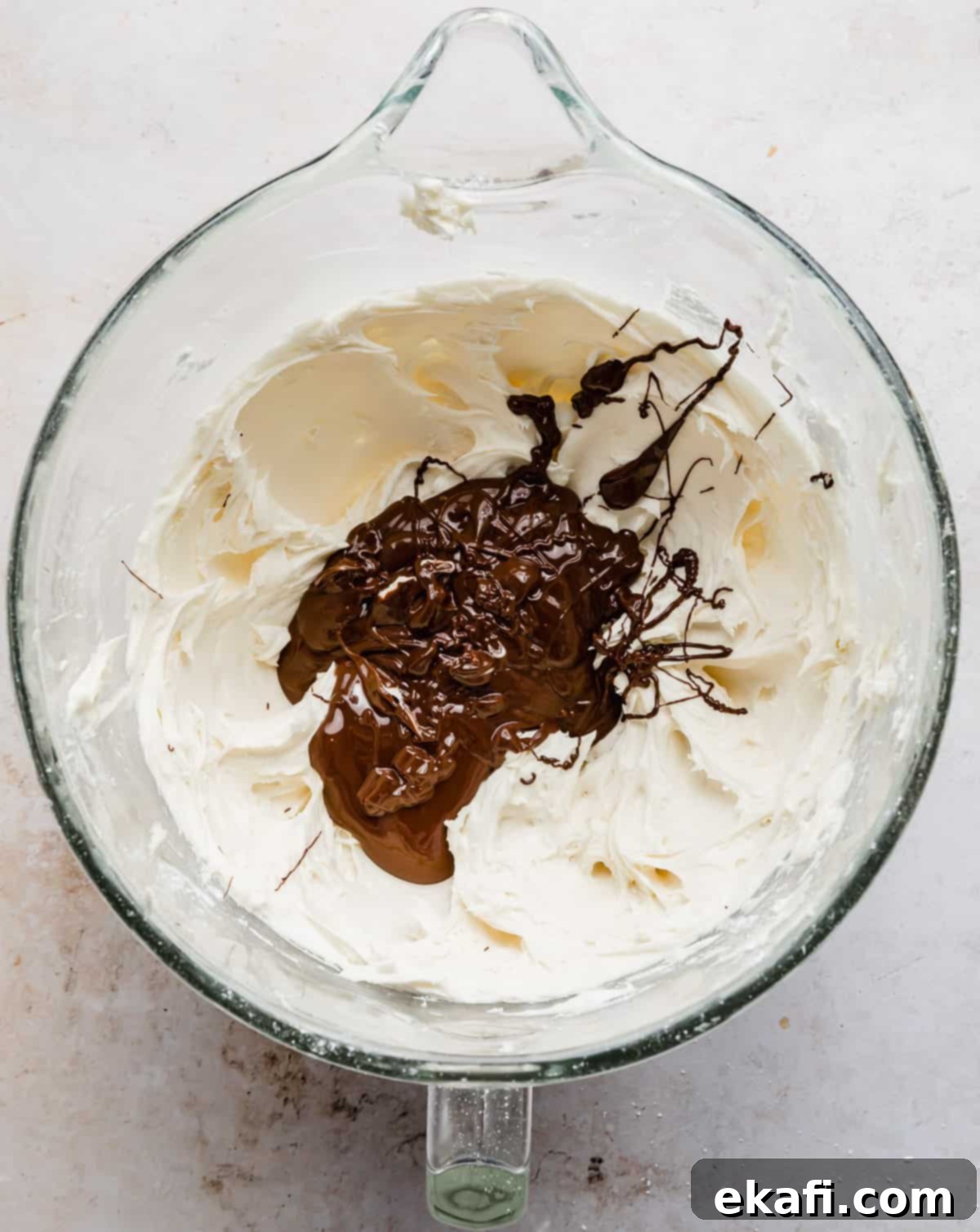
- Whip Until Smooth and Fluffy: Increase the mixer speed to medium-high and beat for another 2 minutes. The chocolate should be fully combined, and the frosting should transform into a smooth, light, and wonderfully fluffy consistency. Stop the mixer occasionally to scrape down the sides of the bowl, ensuring everything is thoroughly incorporated for a consistent texture.
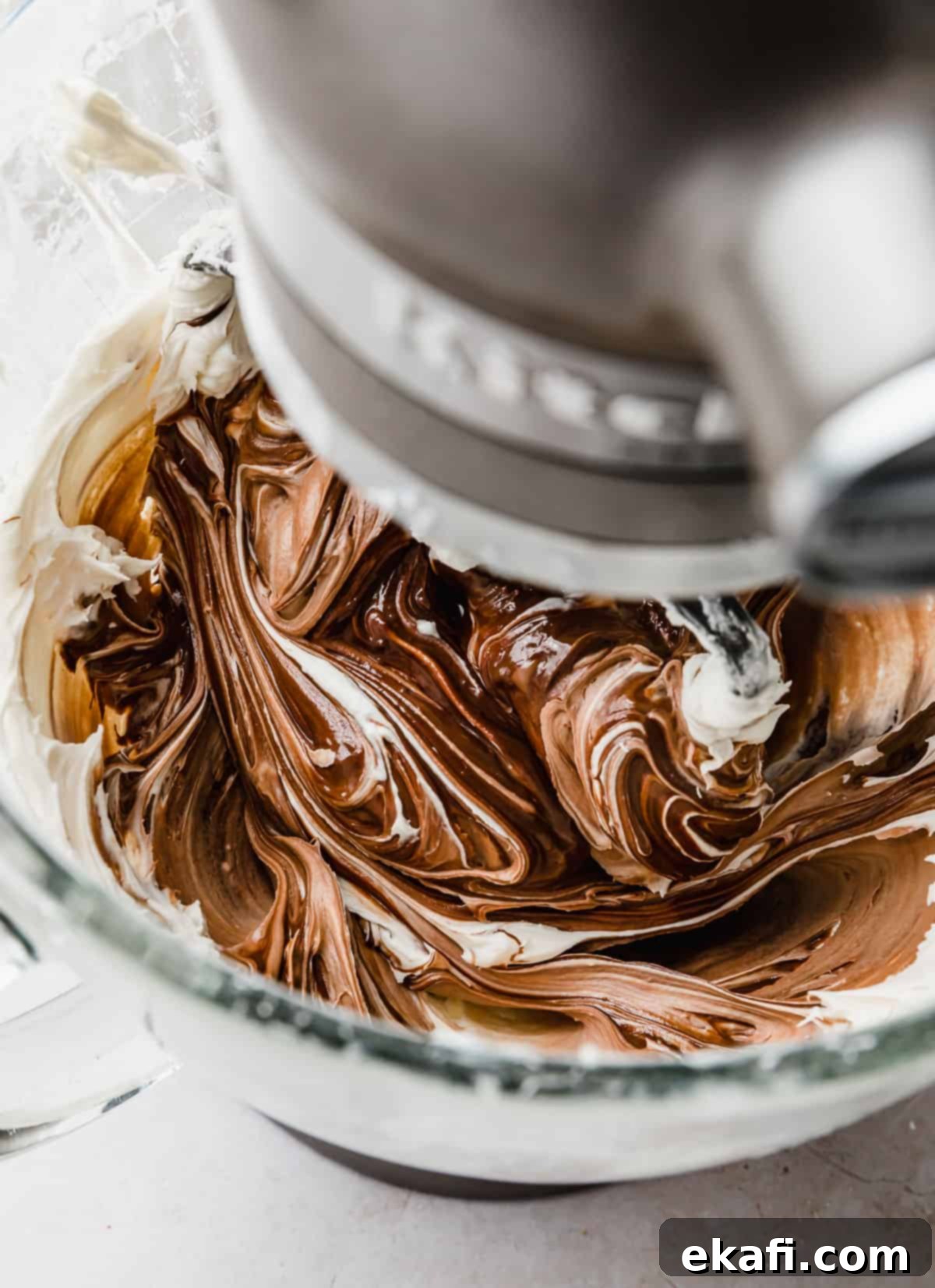
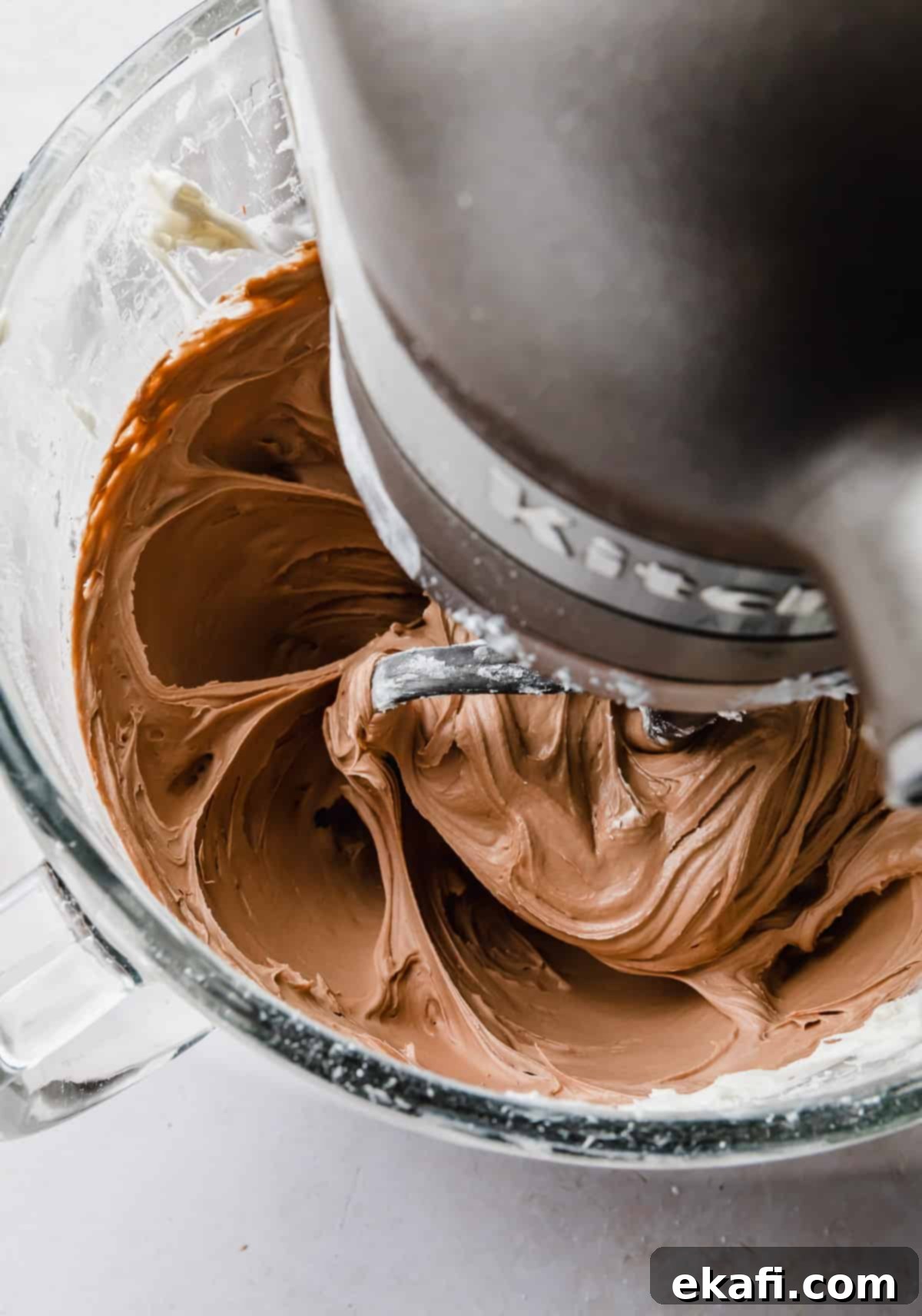
- Adjust Consistency with Heavy Cream (If Needed): If your frosting appears too thick for your needs (e.g., for spreading rather than piping stiff decorations), add a tablespoon of heavy cream and beat for another minute until it reaches your desired light and fluffy texture. You can continue adding small amounts of cream or even a little more sifted powdered sugar to fine-tune the consistency.
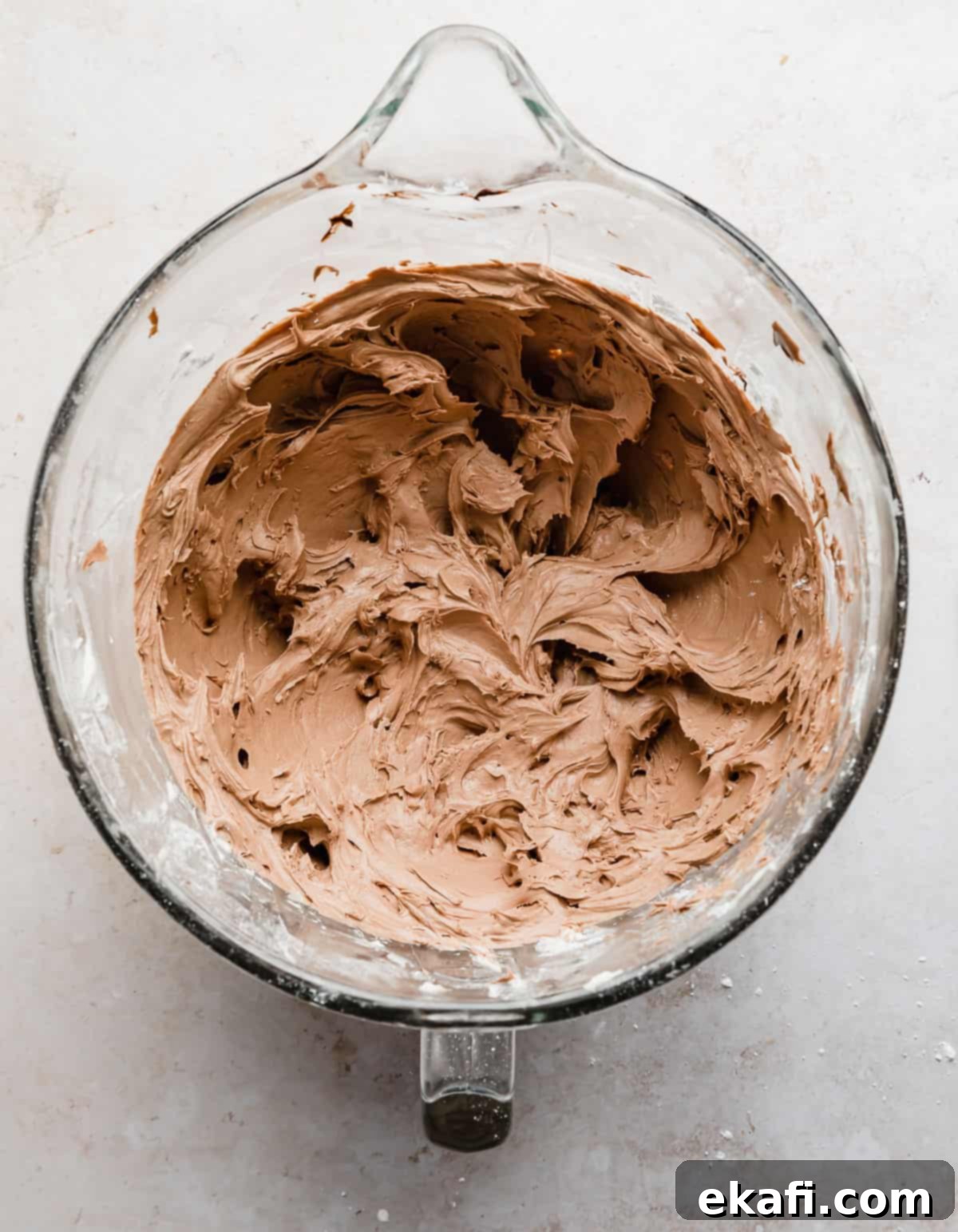
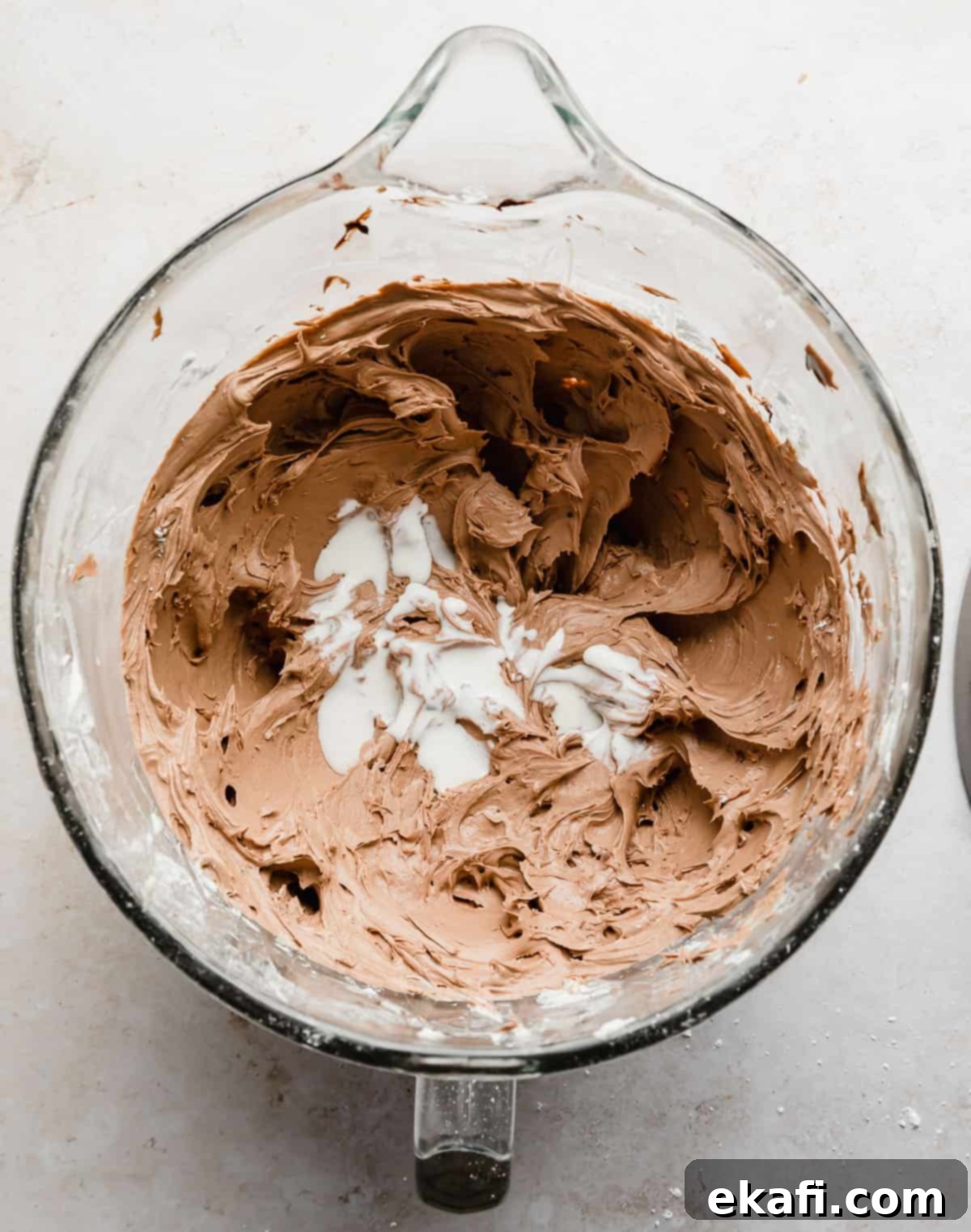
Expert Tips for the Best Chocolate Buttercream
Achieving bakery-quality chocolate buttercream is simpler than you think with these expert tips:
Sifting Powdered Sugar is Non-Negotiable: This step cannot be emphasized enough. Powdered sugar often contains small clumps, which can lead to a grainy buttercream. Sifting it through a fine-mesh sieve before adding it to your butter mixture ensures an incredibly smooth and lump-free frosting. If, after mixing, your buttercream is too thick, gradually add heavy cream, one tablespoon at a time, until you reach your desired spreadable consistency. Conversely, if it’s too thin, a few more tablespoons of sifted powdered sugar can help thicken it up.
Mind the Melted Chocolate Temperature: The temperature of your melted chocolate is paramount. It must be at room temperature – not warm or hot. Introducing hot chocolate to cold butter will cause the butter to melt, resulting in a runny, separated mess that’s nearly impossible to salvage. To melt chocolate safely and effectively in the microwave, heat it in short, 30-second intervals, stirring vigorously after each interval. This prevents scorching and ensures a smooth, even melt. Once fully melted, let it cool for 5-10 minutes until it’s cool to the touch but still liquid.
The Butter’s Crucial Role: As mentioned, use butter that is slightly cold but not firm. This seemingly nuanced temperature is key to a stable and fluffy buttercream. Butter that is too soft or completely at room temperature will become overly lax when whipped, leading to a thin and unstable frosting. The slight chill helps the butter maintain its structure as it incorporates air during the creaming process. Ensure your butter is thoroughly creamed until it’s light in color and airy in texture before introducing other ingredients. This step builds the foundation for your buttercream’s final consistency.
Scrape Down the Bowl Frequently: During all mixing stages, especially after adding powdered sugar and melted chocolate, pause to scrape down the sides and bottom of your mixer bowl. This ensures that all ingredients are fully incorporated, preventing pockets of unmixed butter or sugar and guaranteeing a uniform, silky texture throughout your buttercream.
Rewhip for Freshness: If you’re storing your frosting and planning to use it later, it’s essential to re-whip it before decorating. Buttercream can stiffen in the fridge. Bringing it back to room temperature and giving it a good whip in your stand mixer or with electric beaters will restore its light, fluffy, and spreadable consistency, making it perfect for piping or spreading.
Yield Information: This robust recipe yields a generous amount of frosting, enough to beautifully cover approximately 18-24 standard cupcakes (depending on the height of your swirls) or a stunning 3-tiered 8-inch cake. Adjust quantities as needed for larger or smaller projects.
If you’ve fallen in love with this rich chocolate frosting, you’ll also adore our equally delicious white chocolate version! It offers a delightful contrast and another excellent option for your baking repertoire.
Make Ahead, Storing, and Freezing Your Chocolate Buttercream
One of the many advantages of this chocolate buttercream is its excellent shelf life and freezer-friendliness, allowing you to prepare it in advance for convenience.
Storing in the Refrigerator: To store your chocolate buttercream frosting, transfer it to an airtight container. It will keep beautifully in the refrigerator for up to 1 week. When you’re ready to use it, remove the container from the fridge and allow the frosting to come to room temperature for several hours. This is crucial for its texture. Once at room temperature, give it a thorough whip in your stand mixer (with the paddle attachment) or with electric hand beaters. This re-emulsifies the butter and sugar, returning the buttercream to its original light, fluffy, and pipeable consistency. You might need to add a touch of heavy cream if it seems too stiff after re-whipping.
Freezing for Longer Storage: For extended storage, place the chocolate buttercream in an airtight, freezer-safe container. It can be stored in the freezer for up to 2 months. To thaw, transfer the container to the refrigerator overnight. The next day, remove it from the fridge and let it come to room temperature on your counter. Just like with refrigerated frosting, re-whip it with your stand mixer or electric beaters until it’s light and fluffy again. You may find that adding a few tablespoons of sifted powdered sugar helps restore its perfect texture after thawing and re-whipping.
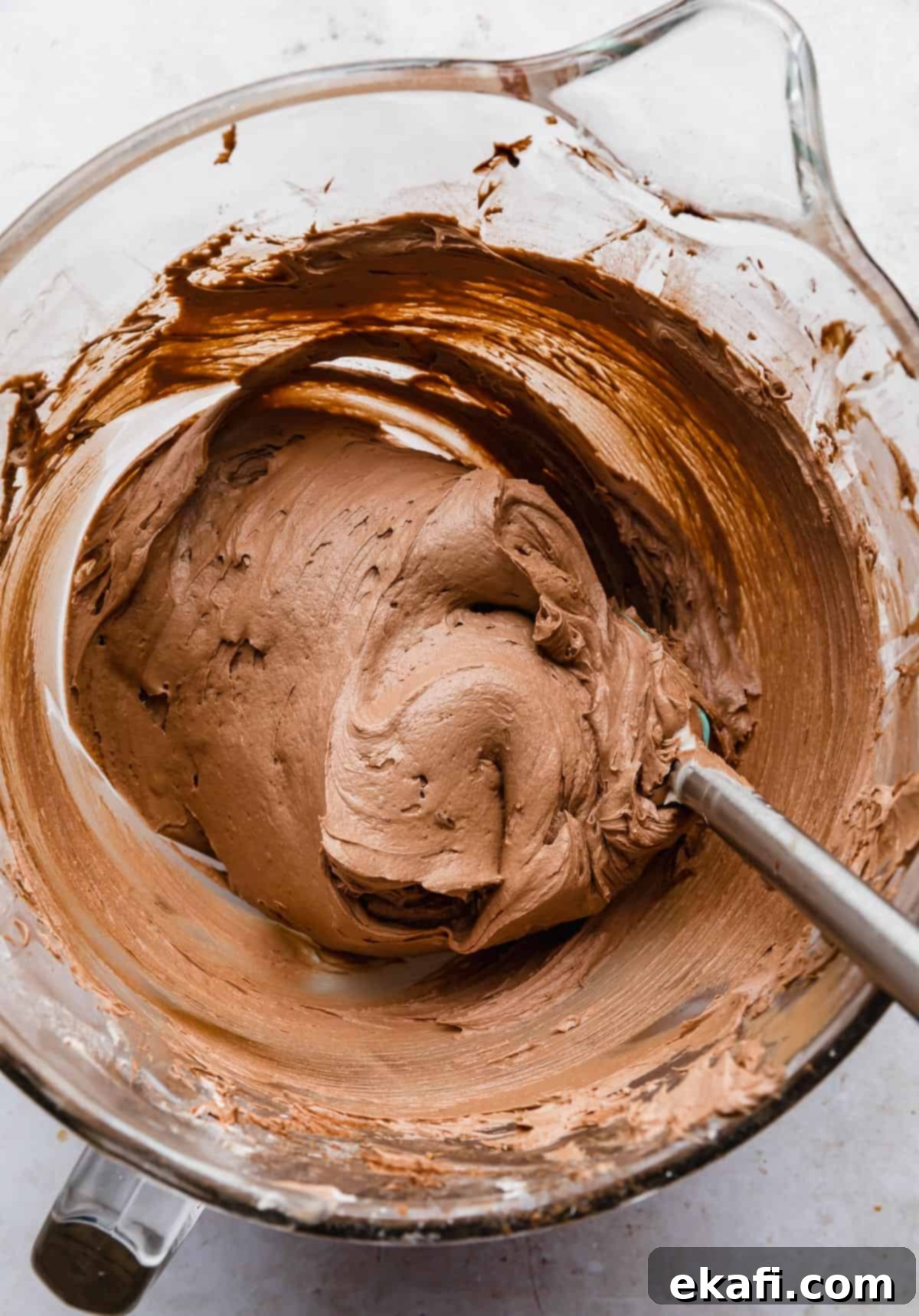
Frequently Asked Questions About Chocolate Buttercream
Buttercream is a classic frosting staple, typically made by creaming together butter (or another fat like shortening, or a combination), powdered sugar, and a liquid, usually heavy cream or milk, until it’s light and fluffy. This base can then be flavored in countless ways – with chocolate, fruit purees, various extracts, or even coffee. This specific recipe focuses on a very approachable and straightforward American buttercream style, known for its ease of preparation and delicious, sweet profile. It’s incredibly versatile and pairs wonderfully with cookies, brownies, or chocolate cupcakes – or honestly, straight off the spoon! 🙂
Absolutely! Freezing chocolate buttercream is a fantastic way to prepare ahead or save leftovers. To do so, store the frosting in an airtight, freezer-safe container. It will remain fresh in the freezer for up to 2 months. When you’re ready to use it, remember to plan ahead: remove the buttercream from the freezer and let it thaw gradually in the fridge overnight. The following day, take it out of the refrigerator and allow it to come fully to room temperature on your counter. Before decorating, give it a vigorous whip in your stand mixer or with electric beaters. This re-incorporates any separated fats and air, restoring its beautiful light and fluffy texture, ready for piping or spreading.
While it’s possible to use salted butter, it’s generally recommended to stick with unsalted butter for baking, especially in recipes where salt isn’t explicitly listed. In many recipes, you can adjust the added salt to compensate for salted butter. However, this particular chocolate buttercream recipe doesn’t call for any additional salt, relying on the natural balance of the ingredients. Using salted butter here will introduce an unmeasured amount of salt, which could subtly alter the flavor profile of your frosting, potentially making it too salty or throwing off the balance with the sweetness of the chocolate. For the intended rich, sweet, and smooth flavor, unsalted butter is the preferred choice.
Technically, you *can* use chocolate chips, but for the absolute best results and the silkiest texture, a high-quality chocolate bar (semi-sweet or bittersweet baking chocolate) is strongly recommended. The reason lies in their composition: chocolate chips are designed with added stabilizers and less cocoa butter, which helps them maintain their shape even when heated. This is why they don’t completely melt into a gooey mess in your Chocolate Chip Cookies. Baking chocolate, on the other hand, contains a higher percentage of cocoa butter and fewer stabilizers, allowing it to melt much more smoothly and evenly. This smooth melting quality directly contributes to the luxurious, non-gritty texture we aim for in this buttercream. If you do use chips, ensure they are high quality and expect a slightly less smooth finish.
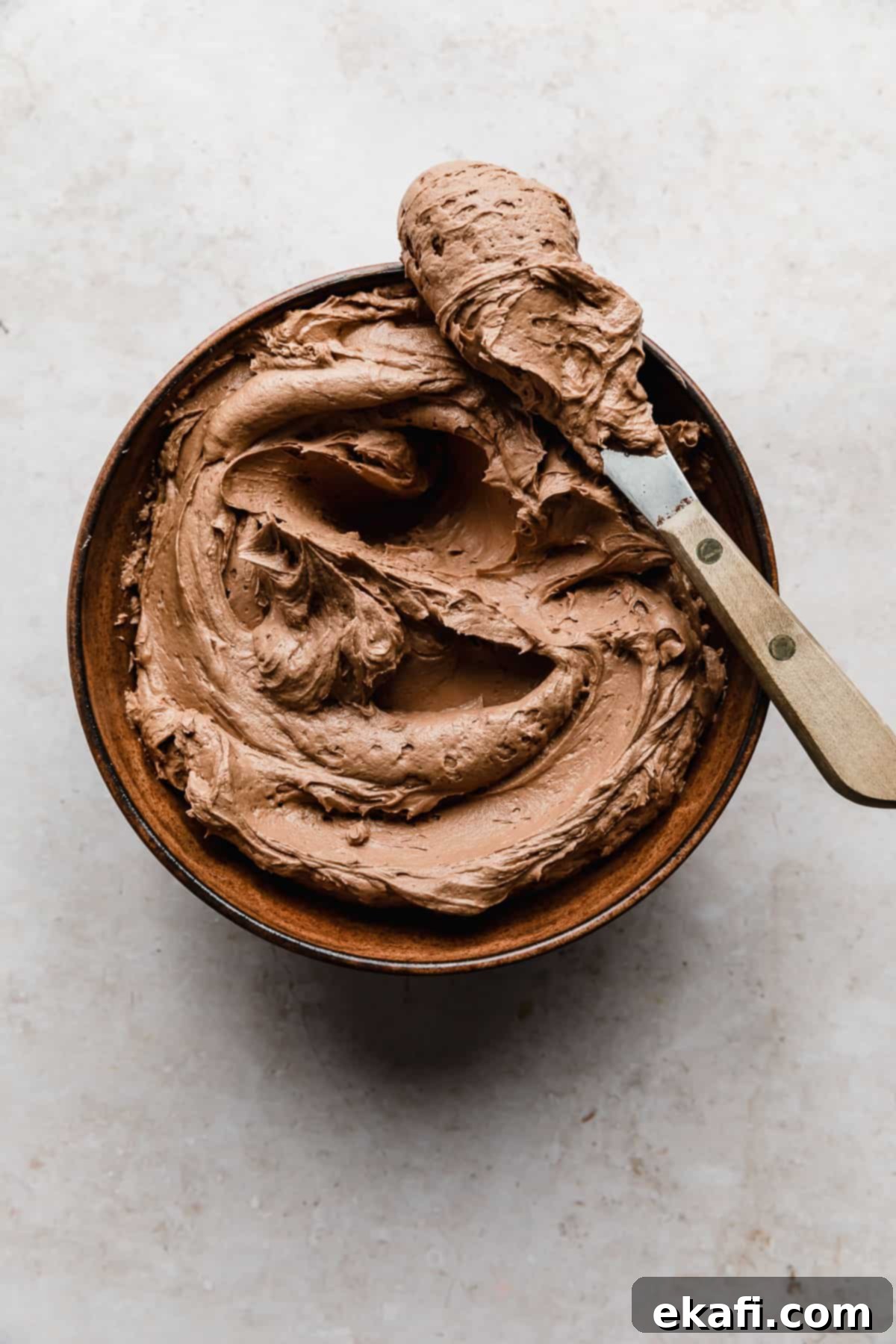
Explore More Delicious Frosting Recipes
If you’ve enjoyed mastering this chocolate buttercream, expand your frosting repertoire with these other fantastic recipes:
- Peanut Butter Frosting: A dreamy, creamy frosting bursting with rich peanut butter flavor, perfect for chocolate cakes or brownies.
- Coconut Pecan Frosting: A classic, rich, and nutty topping that’s essential for German chocolate cake or any coconut lover’s delight.
- Swiss Meringue Buttercream: A more advanced but incredibly stable, less sweet, and super silky buttercream, ideal for delicate decorations.
- Small Batch Cream Cheese Frosting: Perfect for when you need just enough tangy-sweet frosting for a few cupcakes or a smaller cake.
- Nutella Frosting: A decadent and easy frosting combining the hazelnut-chocolate goodness of Nutella with classic buttercream.
Did you make this recipe? We’d absolutely love to hear about your experience! Click here to leave a rating and review directly, or simply scroll down to the recipe card section to share your thoughts there. Your feedback helps us and other bakers!
Stay connected and up-to-date with our latest recipes, tips, and baking adventures by following us on Instagram, joining our community on Facebook, and finding inspiration on Pinterest.
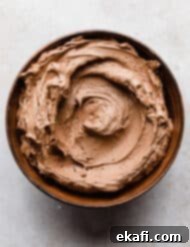
Print
Save
Saved!
Review
Chocolate Buttercream Frosting (with melted chocolate)
2 minutes
5 minutes
7 minutes
18-24
cupcakes or a 3-tier 8-inch cake
Prevent your screen from going dark
Ingredients
-
1 1/2
cups
unsalted butter –
slightly chilled, not fully at room temperature, should still feel cool. -
4
cups
powdered sugar –
sifted for best results. -
1
teaspoon
vanilla extract -
6
oz
semi-sweet chocolate –
or bittersweet chocolate, finely chopped, good quality baking bar. -
1
tablespoon
heavy cream –
add more if needed for desired consistency.
Equipment
-
Stand mixer (or electric hand mixer)
-
Kitchen scale (optional, for precise chocolate measurement)
-
Fine-mesh sieve (for powdered sugar)
Instructions
-
Finely chop the chocolate. Melt it in a microwave-safe bowl at half power (50%), stirring every 30 seconds until completely smooth. Set aside to cool to room temperature for at least 5-10 minutes. It’s crucial not to add warm or hot melted chocolate to the butter, as it will melt the buttercream.
-
In the bowl of a stand mixer fitted with the paddle attachment, whip the slightly chilled unsalted butter on medium-high speed for 2-3 minutes until it’s light in color and fluffy. Reduce the speed to low and gradually add the sifted powdered sugar. Once fully incorporated, add the vanilla extract. Beat for an additional 30 seconds on medium speed, scraping down the sides of the bowl as needed.
-
Pour the cooled melted chocolate into the butter mixture and beat on medium-high speed for 2 minutes or until the chocolate is fully combined, and the frosting is smooth, light, and fluffy. Make sure to scrape down the sides and bottom of the bowl to ensure even incorporation. If needed, add a tablespoon of heavy cream and beat for another minute to achieve your desired consistency.
Notes
To store frosting in the fridge: Keep it in an airtight container for up to 1 week. Before use, remove the frosting from the fridge and allow it to come to room temperature. Rewhip thoroughly in a stand mixer to restore its light and fluffy texture.
To store in the freezer: Place in an airtight container and freeze for up to 2 months. To thaw, transfer it to the fridge a day before you plan to use it. Once thawed, let it come to room temperature before rewhipping. You may need to add a few tablespoons of sifted powdered sugar and re-whip until light and fluffy again.
Always sift your powdered sugar before adding it for the smoothest, lightest texture possible.
Nutrition
Calories:
3752
kcal
(188%)
Carbohydrates:
514
g
(171%)
Protein:
14
g
(28%)
Fat:
203
g
(312%)
Saturated Fat:
128
g
(640%)
Cholesterol:
529
mg
(176%)
Sodium:
59
mg
(2%)
Potassium:
928
mg
(27%)
Fiber:
19
g
(76%)
Sugar:
472
g
(524%)
Vitamin A:
6115
IU
(122%)
Calcium:
147
mg
(15%)
Iron:
8.2
mg
(46%)
Whitney Wright
Dessert
American
Did you make this recipe?
Please leave a star rating and review on the blog post letting me know how you liked this recipe! Take a picture and tag @saltandbaker on TikTok, Instagram, and Facebook so I can see what you’re making!
Having crafted chocolate frosting countless times over the years, I’ve developed a strong preference for recipes that feature real melted chocolate. This method consistently delivers a richer flavor and a superior, silkier texture. This particular recipe was significantly updated on November 29, 2021, incorporating fresh photos, detailed step-by-step instructions, and an adapted recipe specifically to highlight the use of melted chocolate over cocoa powder for an enhanced experience.
Originally published on June 11, 2019, this recipe was further republished and refreshed on January 17, 2022, with additional valuable information, new photos, and refined instructions to ensure you achieve the most exquisite chocolate buttercream every time.
